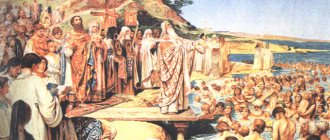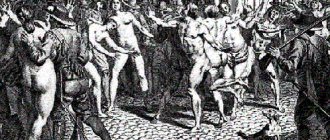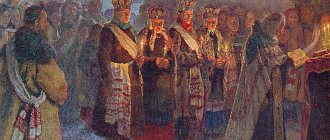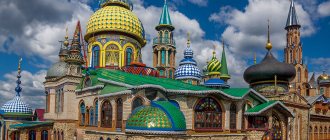Russian spiritual mission in China
(inactive, the Chinese Orthodox Church now exists)
In 1698, Vinius, the Duma clerk, wrote from Tobolsk to Tsar Peter I abroad that a Russian church had been built in Beijing and that many Chinese had been baptized. On June 18, 1700, Tsar Peter issued a decree that ensured the future of the Orthodox mission in Beijing. In the Decree, the emperor ordered to begin searching for people suitable for missionary work in China.
In 1712, after the death of Father Maxim Tolstoukhov (a Russian priest who came to China with captured Albazin Cossacks after the defeat of the Albazin fortress), the Albazinians again raised the issue of sending a shepherd to them. A request was sent to China for the possibility of a Russian mission preaching there. At that time, Emperor Kangxi sent an embassy to the Kalmyks in the Caspian steppes with the permission of the Russian authorities, which is why he reacted favorably to the request and only indicated that a doctor skilled in the treatment of external diseases should be sent to China with the Mission. Kangxi's resolution was immediately reported to Tsar Peter, who ordered Saint John of Tobolsk to select worthy people for this Mission. By order of the Metropolitan, Archimandrite Hilarion (Lezhaisky) was appointed head of the first spiritual mission to China in 1713. The priest Lavrenty (he was probably in Beijing as a deacon in 1696 during the consecration of the St. Nicholas Chapel in the Church of St. Sophia) and the deacon Philemon (his biography is unknown) went with him. They were joined by seven churchmen, probably from the students of the Tobolsk Slavic-Russian school, opened by Metropolitan Philotheus in 1704.
The mission's tasks initially included, in addition to pastoral care of the Orthodox in Beijing, scientific activity and the implementation of diplomatic functions. The first Orthodox mission from Russia arrived in Beijing in 1716 and was received with special honor and attention. Bogdykhan enrolled its members in the highest classes of the state, namely: he awarded the archimandrite a mandarin of the 5th degree, the priest and deacon - mandarins of the 7th degree, and the students were ranked as soldiers. All members of the mission were allocated government apartments near the Albazin church and, probably, plots of land, as well as temporary cash benefits. In addition to this, the tribunal ordered them to receive a monthly salary. To complete his favor, the Bogdykhan gave some of the churchmen wives, no doubt baptized by them, and assigned those who had studied Chinese and Manchu to the tribunal of foreign relations to translate letters received from the Russian Senate and sent to the Senate by the Chinese Collegium of Foreign Affairs. Little information has been preserved about the activities of the first Mission. It is known that, thanks to its good composition, it attracted a number of local residents to the Russian Church, who went to the harmonious divine service instituted by the arch. Hilarion. Bogdykhan sent an official every month to inquire about the health of the head of the Mission (whereas after that he did this only twice a year, which, according to native concepts, was a great honor).
From 1716 to 1933, 20 missions and over 200 preachers were sent to China. The Mission was built through the labors of many generations, and its past was sanctified by the prayers of holy ascetics. Thus, Saint John, Metropolitan of Tobolsk, Saint Innocent, Bishop of Irkutsk, took a direct part in its emergence and development.
The Beijing Mission was not the only one, but the earliest in terms of its founding of the foreign missions of the Russian Orthodox Church. At the same time, the Russian Spiritual Mission in Beijing was a unique Russian institution abroad, not only representing the Russian Orthodox Church in Qing China, but also for 150 years, from 1715 to 1864, acting as an unofficial diplomatic representation of Russia in China.
The main task of the missionaries in China was to study the Chinese and Manchu languages. The Chinese language was studied for the purpose, firstly, of conducting sermons, and secondly, of studying and researching the culture of China. During the existence of the Mission, thirty-seven churches were built (including churches in Beijing, Harbin, Tianjin, Shanghai, which were distinguished by their originality), more than forty preaching points were created, five dioceses (Beijing, Tianjin, Xinjiang, Shanghai, Harbin), and an Orthodox church was established. a seminary, twenty men's and women's religious schools, religious teachings were disseminated, a library was opened, a publishing house was founded and the magazine “Chinese Evangelist” (“Zhongguo fuyn bao”) was published in Russian, English and Chinese, and charitable activities were carried out. At the same time as preaching, the missionaries studied Chinese astronomy, history, geography, nationalities, religion, folk customs and much more.
The second half of the 19th century marks the initial period of the spread of Orthodoxy in China beyond the capital of the Empire. The Russian Spiritual Mission in Beijing in 1864 was relieved of its duties of performing diplomatic functions in connection with the opening of the Russian Embassy. Members of the Mission, scientists and theologians, began work on translating liturgical literature into Chinese. This period of the Mission’s activity is also famous for the Sinological works of its members, which laid the foundation for Russian Sinology. The beginning of the century was a brief period of heyday for the Beijing Mission. Over the course of several decades, many translations of the Holy Scriptures into Chinese were made, the main liturgical texts and some works of the holy fathers were translated. In those years, the Mission published both scientific works of members of the Beijing Mission and church books. The first Chinese monastery was founded in Beijing. Metochions of the Beijing Mission operated in Moscow and St. Petersburg.
The mission was closed in 1954, five years after the Chinese Revolution.
Currently, the Russian Embassy in China is located on the territory of the Mission. On the territory of the Embassy, with the blessing of His Holiness Patriarch Alexy of Moscow and All Rus', on April 19, 1997, a Worship Cross was installed in memory of the history of the Mission, Orthodox Chinese and Russian sinologists. On the territory of the Embassy, the former Assumption Church, converted into a garage, has been preserved. In August 1997, on the initiative of the Embassy, part of the Western wall of the former Mission, adjacent to the Assumption Church, was restored and actually restored.
Today, only stones remind of the past history of the Mission in Beijing - the remains of the tombstones of the Russian cemetery behind the former Andingmen Gate of the city.
Back in 1986, on the territory of Qingnianhu Park, into which the cemetery was turned, the St. Seraphim Church was destroyed. The former Ambassadorial Church in the Nantang district was destroyed in 1991. The Beijing Bell Museum houses two Russian bells - one taken from the Mission bell tower, the other from the St. Seraphim Church. One of the museums in Beijing houses the tombstone of the Head of the 1st Spiritual Mission, Archimandrite Hilarion (Lezhaisky).
Chiefs
Until the second half of the 19th century, missions were sent approximately once a decade. In the event of the death of the head of the mission before the expiration of the term, the new chief arrived to replace him only as part of the next mission.
- 1st mission 1717-1728 - Hilarion (Lezhaisky), archim., (+ 1717)
- 2nd mission 1729-1735 - Anthony (Platkovsky), archimandrite.
- 3rd mission 1736-1745 - Hilarion (Trusov), archim., (+1741)
- 4th mission 1745-1755 - Gervasy (Lintsevsky), Pereyaslavsky, archimandrite.
- 5th mission 1755-1771 - Ambrose (Yumatov), archim., (+1771)
- 6th mission 1771-1781 - Nikolai (Tsvet), archimandrite.
- 7th mission 1781-1794 - Joachim (Shishkovsky), archimandrite.
- 8th mission 1794-1807 - Sophrony (Gribovsky), archimandrite.
- 9th mission 1807-1821 - Iakinf (Bichurin), archimandrite.
- 10th mission 1821-1830 - Peter (Kamensky), archimandrite.
- 11th mission 1830-1840 - Veniamin (Moracevich), hierome, then archimandrite.
- 12th mission 1840-1849 - Polycarp (Tugarinov), archimandrite.
- 13th mission 1850-1858 - Palladium (Kafarov), archimandrite.
- 14th Mission 1858-1864 - St. Gury (Karpov), archimandrite.
- 15th mission 1865-1878 - Palladium (Kafarov), archimandrite.
- 16th mission 1879-1883 - Flavian (Gorodetsky), archimandrite.
- 17th mission 1884-1896 - Amfilokhiy (Lutovinov), archimandrite.
- 18th mission 1896-1931 - Innocent (Figurovsky), archimandrite, from 1902 - bishop. Pereyaslavsky, from 1918 - Beijing, from 1921 - archbishop, from 1922 - archbishop. Beijing and Chinese, from 1928 - Metropolitan.
- 19th mission 1931-1933 - Simon (Vinogradov), archbishop. Beijing and Chinese.
- 20th mission 1933-1956 - Victor (Svyatin), bishop. Beijing and China, since 1938 - archbishop.
The Russian Spiritual Mission in China is being revived
On June 11 of this year, at a meeting of the Council of the Moscow Theological Academy, a decision was made to create at the Academy a Center for studying the problems of the Orthodox mission in the Far East, and an employee of the Educational Committee of the Russian Orthodox Church, E.Yu., was appointed head of the Center. Petrovsky.
The Russian Spiritual Mission in China, created during the reign of Peter the Great, was abolished in 1954. In 1957, the Holy Synod of the Russian Orthodox Church decided to grant autonomous status to the Chinese Orthodox Church. At that time there were about 20,000 Orthodox Christians in China.
In 1997, the 40th anniversary of the autonomy of the Orthodox Church in China was celebrated. A special meeting of the Holy Synod of the Russian Orthodox Church, held on February 17, 1997, was dedicated to this event. The meeting examined the historical path and current situation of the Chinese Autonomous Orthodox Church. The members of the Synod concluded that “the granting of autonomous status to the Chinese Autonomous Orthodox Church was a timely step, consistent with the situation of the dioceses on the territory of the People’s Republic of China and reflecting their readiness to move to a form of independent government. The thousand-year service of the Russian Orthodox Church to the Fatherland and the people was, as a fundamental principle of relations with state power, organically adopted by the Chinese Autonomous Orthodox Church from the Mother Church and embodied by it in serving its great fatherland.”
The Council of Bishops of the Russian Orthodox Church, held in the same year, approved the definitions adopted by the Holy Synod, testifying to the preservation of the autonomous status of the Chinese Orthodox Church and the inviolability of its canonical borders.
Currently, the Primate of the Chinese Autonomous Orthodox Church is His Holiness Patriarch of Moscow and All Rus' Alexy II, and the head of the Department of External Church Relations is Metropolitan Kirill of Smolensk and Kaliningrad.
In the summer of 2000, another anniversary of the Chinese Church was celebrated - the 100th anniversary of the martyrdom of 222 Orthodox Chinese, led by the Hieromartyr Mitrofan, killed during the anti-colonial Boxer Uprising in Beijing.
Today it has become quite obvious that we are faced with the urgent task of reviving the Orthodox mission in China. In addition to the revival of Orthodoxy in China, it is also necessary to organize a mission among the Chinese permanently residing in Russia. According to various estimates, about half a million Chinese live in Moscow alone. Protestant preachers, usually of Korean origin, are active among them and have great success. As a result, the vast majority of Chinese who convert to Christianity become Protestants in an Orthodox country.
Of course, our Church is also taking certain steps to revive the Orthodox mission among the Chinese. The Department for External Church Relations has developed a program for creating diocesan Centers for studying the problems of the Orthodox mission in China. At the beginning of July of this year, 5 students from the PRC are sent through the DECR to study at the Moscow Theological Seminary, Regency and Icon Painting Schools.
In the 2000-2001 academic year, on the initiative of the Educational Committee, elective classes in the Chinese language, Chinese culture and philosophy were organized for first-year students of the Moscow Theological Seminary. At the end of the first half of the year, an exam was held, which 6 out of 12 students successfully passed. In the second half of the year, classes were conducted according to a fairly intensive program and taking into account the individual abilities of each student. As a result, by the end of the school year, the students mastered the skills of elementary conversational speech, the basics of hieroglyphics and began studying the catechism and prayer books in Chinese. Chinese language textbooks with audio cassettes, aids for studying hieroglyphs and dictionaries were purchased for students.
This initiative received the approval of the Chairman of the Department for External Church Relations of the Moscow Patriarchate, managing the affairs of the Chinese Autonomous Orthodox Church, Metropolitan Kirill of Smolensk and Kaliningrad (letter No. 1510 of May 29, 2001). Moreover, in the 2001/02 academic year, the Department for External Church Relations agreed to send an employee of the Department, priest Dionisy Pozdnyaev, to give lectures on the history and current state of the Chinese Autonomous Orthodox Church at the IBC.
As part of the project for the development of international relations of theological educational institutions of the Russian Orthodox Church, the program for studying the Chinese language and teaching students from the PRC at the Moscow Theological Academy and Seminary was approved by the Subcommittee on Orthodox Education of the Socio-Political Expert Council under the Plenipotentiary Representative of the President of the Russian Federation in the Central Federal District and adopted by as a project implemented with the support of the subcommittee (Minutes of the meeting of the subcommittee No. 3 dated June 1, 2001).
It seems that the opportunity for Chinese students to communicate with seminary students studying Chinese will be mutually beneficial both in terms of language practice and in terms of establishing personal contacts and will certainly serve the cause of reviving the Orthodox mission in China. The Center for Studying the Problems of the Orthodox Mission in the Far East, which is being created at the Academy, is also called upon to solve this important problem.
The Orthodox mission in the 19th century is the cradle of Russian Sinology[edit]
The tasks of the members of the Beijing Spiritual Mission included studying the Manchu, Chinese and Mongolian languages, as well as the history, culture and religion of China. Young people from among students of higher educational institutions and the Theological Academy were appointed among the secular members of the mission. Classes were distributed among students according to their prior knowledge, desire and abilities; they studied medicine, mathematics, literature and philosophy, the Confucius system, history, geography, statistics and jurisprudence of the Chinese state. The Beijing mission gave Russia its first prominent sinologists, among whom can be named Rassokhin I.K. (1707-1761), Leontyev A.L. (1716-1786), Bichurin I.Ya. (1785-1853 gg.), Kovalevsky O. M. (1800-1878), Zakharov I. I. (1814-1885), Kafarov P. I. (1817-1878), Vasiliev V. P. (1818 -1900). The scientific heritage of these ascetics still represents a real treasury of Russian Sinology. For example, the description of Beijing, compiled by the head of the ninth mission, Archimandrite Iakinf (Bichurin), essentially formed the basis for all subsequent European guides to the capital of China.
Iakinf Bichurin was the head of the ninth spiritual mission from 1808 to 1820. She was one of the most brilliant in the entire history of the mission. In the missionary field, her activity was rather weak, but her students and Bichurin himself left a noticeable mark on sinology. Bichurin quickly learned the language and made numerous acquaintances, which gave him invaluable knowledge of the customs and morals of the country. Fourteen years of life in Beijing became a stage of preparation for his scientific and literary activities. Bichurin created many works on the geography, history, and literature of China, and compiled several dictionaries. His works were recognized by the Russian Academy of Sciences and the Parisian Asiatic Society.
Orthodox mission after the Opium Wars[ | ]
Hankow: The Former Russian Church (1876)
Russia did not directly participate in the Opium Wars against China, and even remained after the recent Crimean War in conflict with England and France - the victors of these wars and sympathized with the anti-British sepoy uprising in India. However, Russian diplomats, by threatening to invade China and open a second front during the Christian Taiping Uprising, achieved the annexation of vast Manchu territories (Transbaikalia, Khabarovsk Territory, Primorsky Territory, Sakhalin, etc.) to Russia. After the signing of the Aigun Treaty in 1858, a series of Tianjin treaties and the Beijing Treaty of 1860 between the Qing Empire and Western countries, the position of the Russian Spiritual Mission changed. Diplomatic missions of Western states, including Russia, opened in Beijing. In 1861, the first permanently accredited Russian envoy with the rank of Resident Minister L.F. Balluzek arrived in Beijing, and a permanent Russian diplomatic mission was established in the capital of the Qing Empire, to which its diplomatic and significant part of educational functions were transferred from the spiritual mission. The spiritual mission turned into an institution with exclusively religious (missionary) functions and moved from the jurisdiction of the Ministry of Foreign Affairs to the spiritual department. The mission staff has been reduced.
The Qing government, recognizing that Christian teaching contributed to the establishment of order and harmony between people, pledged not to persecute its subjects for their adherence to the Christian faith.
This policy of the Qing government made it possible to develop the religious activities of the mission, which from that moment began preaching Orthodoxy among the Chinese. Many liturgical books were translated and published into Chinese. Typically, these books were used by Protestants and allowed them to achieve that out of 105.4 million Chinese Christians in our time, 75 million were Protestants. At the end of the 19th century, Russian concessions were opened in Tianjin, Fuzhou and Hankou.
On March 10, 1862, in the village of Dong-ding, 53 kilometers east of Beijing, the first liturgy was celebrated in a specially constructed room, and in 1863 the Russian press reported[2] that there, by Russian merchants trading in China, it was decided to build an Orthodox church with money donated by baptized Chinese.
Since 1864, the Mission has lost its diplomatic character, becoming exclusively religious and educational[3]. In 1882, the first Chinese Orthodox priest, Mitrofan Ji, began conducting Christian worship in Chinese for the first time in modern times (Catholics began only after the Second Vatican Council in 1964).
In 1895, Russia again took advantage of China's defeat in the war with Japan: it took possession of the Liaodong Peninsula, on which it built the city of Port Arthur and declared Manchuria its sphere of influence, through which it ran the Chinese Eastern Railway from Chita to Vladivostok and Port Arthur. This caused outrage in China and led to the Boxer Rebellion.
Literature[ | ]
- A brief history of the Russian Orthodox mission in China, compiled on the occasion of the bicentennial anniversary of its existence in 1913. 1st edition, Beijing, Printing house of the Assumption Monastery, 1916.
- Kuznetsova T.V.
Publishing activities of the Russian Spiritual Mission (on the example of publications from the collections of the Far Eastern State Scientific Library) // “Evolution and revolution: experience and lessons of world and Russian history: Materials of the international scientific conference.” Khabarovsk, September 22-24, 1997 - Khabarovsk. - 1997. - pp. 80-85 - Gusterin P.V.
Archimandrite Avvakum (on the history of the signing of the Tianjin Treaty of 1858) // New and recent history. - 2008. - No. 6. - Bei-guan: a brief history of the Russian spiritual mission in China. Alliance-Archeo, 2006. - 214 p.
- Datsyshen V.G.
History of the Russian Spiritual Mission in China / ed. prot. Dionisy Pozdnyaev. - Hong Kong: Brotherhood of the Holy Apostles Peter and Paul, 2010. - 448 p. — ISBN 978-9-88188-956-0 - Golovin S.A.
Russian spiritual mission in China. Historical sketch. — Blagoveshchensk: BSPU Publishing House, 2013.
Albazinians[ | ]
Main article: Albazinians
In the 17th century, Russia began to explore Eastern Siberia and encountered China for the first time. The first contacts were in the nature of border armed conflicts. The most significant of them was the capture of the Russian fortress of Albazin on the Amur River by the Qing army in 1685. 45 Cossacks captured in this case were resettled to Beijing and marked the beginning of the many years of Russian presence in China. Although the Chinese called all these people Russians, among them there were probably also baptized Buryats, Kalmyks and descendants of mixed marriages.
The Albazians were compactly settled in the Inner City at the Dongzhimen Gate. They were ranked by the Manchu Emperor Xuanye (the motto of the reign is “Kangxi”) to the honorary military class, which occupied a high position in the class hierarchy of the Qing Empire, and were enrolled with a decent salary in the “Russian company” of the yellow bordered banner of the imperial guard. Captured Albazians, along with other soldiers, received government apartments, money for the initial establishment of a household, plots of arable land, single Cossacks were married to Chinese women. For worship, the Russians were given possession of the Buddhist idol Guandimiao (Temple of the God of War), which priest Maxim Leontyev, the first Orthodox priest on Chinese soil, turned into a chapel in the name of St. Nicholas the Wonderworker. There, until 1695, he performed divine services, serving the spiritual needs of his flock.
By this time, Russia learned about the activities of Father Maxim and his efforts to preserve the faith among the Albazinians. The Russian government turned to the Chinese emperor with a request to release the prisoners or to allow them to build a Russian church in Beijing. In 1696, Father Maxim, together with clergy who arrived from Russia, consecrated the church in the name of St. Sophia, but it was called Nikolskaya in honor of the icon of St. Nicholas the Wonderworker.
Notes[ | ]
- JY Wong.
Deadly Dreams, p. 28. - Spiritual conversation, published weekly under the editorship of Archpriest Ioann Yakhontov. St. Petersburg, 1863, July // News and notes
- "Church Bulletin, published by the Missionary Council under the Holy Synod." 1917, February 5-12, No. 5-6, stb. 97.
- "Church Bulletin, published by the Missionary Council under the Holy Synod." 1917, February 5-12, No. 5-6, stb. 100.
- "Orthodox Blagovestnik". M., 1917, May - December, p. 182.
- RUSSIAN CHURCH EMIGRATION IN CHINA IN HISTORICAL AND POLITICAL CONTEXT (1917-1945)
- Napara D.
In memory of the Alapaevsk martyrs, hidden in the land of China
(unspecified)
. Orthodoxy.Ru. Access date: May 31, 2009. - ↑ 12
Khisamutdinov A. A. Spiritual missions in China, Korea and Japan (late XIX - first half of the XX centuries) // News of the Eastern Institute. - 2012. - No. 2 (20). — P. 100 - Prayer in Krasnaya Fanza // “Church Bulletin”, No. 10 (383) May 2008 / May 14, 2008








